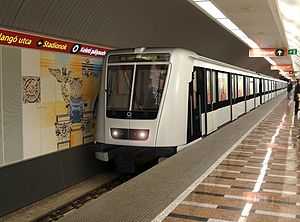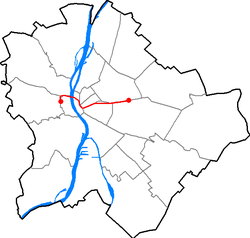Line 2 (Budapest Metro)
| Line 2 | |||
|---|---|---|---|
 | |||
| Overview | |||
| Stations | 11 | ||
| Line number | Line 2 ("Red metro") | ||
| Technical | |||
| Line length | 10.3 km (6 mi)[1] | ||
| Track gauge | 1,435 mm (4 ft 8 1⁄2 in) | ||
| Electrification | 825 V DC | ||
| Operating speed | 70 km/h[1] | ||
| |||
| Metro 2 | |||||||||||||||||||||||||||||||||||||||||||||||||||||||||||||||||||||||||||||||||||||||||||||||||||||||||||||||||||||||||||||||||||||||||||||||||||||||||||||||||||||||||||||||||||||||||||||||||||||||||||||||||||||||||||||||||||||||||||||||||||||||||||||||||||||||||||||||
|---|---|---|---|---|---|---|---|---|---|---|---|---|---|---|---|---|---|---|---|---|---|---|---|---|---|---|---|---|---|---|---|---|---|---|---|---|---|---|---|---|---|---|---|---|---|---|---|---|---|---|---|---|---|---|---|---|---|---|---|---|---|---|---|---|---|---|---|---|---|---|---|---|---|---|---|---|---|---|---|---|---|---|---|---|---|---|---|---|---|---|---|---|---|---|---|---|---|---|---|---|---|---|---|---|---|---|---|---|---|---|---|---|---|---|---|---|---|---|---|---|---|---|---|---|---|---|---|---|---|---|---|---|---|---|---|---|---|---|---|---|---|---|---|---|---|---|---|---|---|---|---|---|---|---|---|---|---|---|---|---|---|---|---|---|---|---|---|---|---|---|---|---|---|---|---|---|---|---|---|---|---|---|---|---|---|---|---|---|---|---|---|---|---|---|---|---|---|---|---|---|---|---|---|---|---|---|---|---|---|---|---|---|---|---|---|---|---|---|---|---|---|---|---|---|---|---|---|---|---|---|---|---|---|---|---|---|---|---|---|---|---|---|---|---|---|---|---|---|---|---|---|---|---|---|---|---|---|---|---|---|---|---|---|---|---|---|---|---|---|---|---|
Legend | |||||||||||||||||||||||||||||||||||||||||||||||||||||||||||||||||||||||||||||||||||||||||||||||||||||||||||||||||||||||||||||||||||||||||||||||||||||||||||||||||||||||||||||||||||||||||||||||||||||||||||||||||||||||||||||||||||||||||||||||||||||||||||||||||||||||||||||||
| |||||||||||||||||||||||||||||||||||||||||||||||||||||||||||||||||||||||||||||||||||||||||||||||||||||||||||||||||||||||||||||||||||||||||||||||||||||||||||||||||||||||||||||||||||||||||||||||||||||||||||||||||||||||||||||||||||||||||||||||||||||||||||||||||||||||||||||||
| |||||||||||||||||||||||||||||||||||||||||||||||||||||||||||||||||||||||||||||||||||||||||||||||||||||||||||||||||||||||||||||||||||||||||||||||||||||||||||||||||||||||||||||||||||||||||||||||||||||||||||||||||||||||||||||||||||||||||||||||||||||||||||||||||||||||||||||||
The Metro 2 (Officially: M2, East-West Line, Unofficially: Red Line) is the second line of Budapest Metro. The line runs east from Déli pályaudvar in north-central Buda under the Danube to the city center, from where it continues east following the route of Rákóczi út to its terminus at Örs vezér tere.
Prior to the 2014 opening of Metro 4, it was the only line that served Buda. Daily ridership is estimated at 451,627.
History
The first plans for the present-day two lines were made in 1942, and the Council of Ministers' decree enacted its building in 1950.[2] Metro 2 was originally planned to connect two major railway stations, Keleti (Eastern) and Déli (Southern) pályaudvar. They wanted to complete the first section by 1954 between Deák Ferenc tér and Népstadion (today Puskás Ferenc Stadion), the second section by 1955 between Déli pályaudvar and Deák Ferenc tér.[3] The construction was ceased for financial and political reasons from 1954 till 1963,[2] the ruling Hungarian Socialist Workers' Party decided to restart the construction on a party congress in 1959.[3] It was finally opened with seven stations on April 4 (then a Communist holiday in Hungary) in 1970, and the second section in 1972.[2] The eastern section was extended to Örs vezér tere, instead of Népstadion.[2] Operation started in 1970 with 3 units, expanded to 4 units soon after. There are five unit-trains on Line 2 since 1972.[4] A major reconstruction of the track and the stations was undertaken between 2004 and 2008, with new trains arriving in 2010.
It runs in an east-west direction through the city, and it was the first metro line to cross the River Danube and reach Buda (the western part of Budapest).[5] It has a transfer station with Line 1 and Line 3 at Deák Ferenc tér, and a transfer station for Line 4 at Keleti pályaudvar.
| Sections[1] | Opened | Length | Stations |
|---|---|---|---|
| Deák Ferenc tér - Örs vezér tere | 1970 | 6.7 km (4 mi) | 7 |
| Déli pályaudvar - Deák Ferenc tér | 1972 | 3.6 km (2 mi) | 4 |
| Total | 1972 | 10.3 km (6 mi) | 11 |
Stations and connections
| Station | Connection | Buildings/Monuments |
|---|---|---|
| Örs vezér tere | 3, 62, 62A 80, 81, 82 161A, 168E, 169E, 174, 176E, 231, 244, 261E, 276E, 277 | Árkád Budapest |
| Pillangó utca | | Kincsem Park |
| Puskás Ferenc Stadion | 1, 1A 75, 77, 80, 80A | Ferenc Puskás Stadium, László Papp Budapest Sports Arena, Kisstadion |
| Keleti pályaudvar | MÁV 24 73, 76, 78, 79, 80, 80A | Keleti pályaudvar, Arena Plaza |
| Blaha Lujza tér | 4, 6, 28, 37, 37A, 62 74 | Boscolo Budapest Hotel |
| Astoria | 47, 48, 49 74 | Danubius Hotel Astoria, Dohány Street Synagogue |
| Deák Ferenc tér | 47, 48, 49 | Deák Ferenc tér, Town Hall, Metro Museum (Földalatti Vasút Múzeum), St. Stephen's Basilica |
| Kossuth Lajos tér | 2 70, 78 | Hungarian Parliament Building, Ethnographic Museum |
| Batthyány tér | | Market Hall |
| Széll Kálmán tér | 18, 59, 61 139, 140, 140A, 149, 155, 156, 222 | Post Palace Budapest, Városmajor |
| Déli pályaudvar | MÁV 18, 59, 61 | Déli pályaudvar |
Gallery
-

Alstom Metropolis train at Keleti pályaudvar
References
- ↑ 1.0 1.1 1.2 Árpád Bodnár: A budapesti metró két évtizede ("Two decades of the Budapest Metro"), Városi Közlekedés, Year XXXI, Vol. 3, pp. 119-121, Budapest, 1991
- ↑ 2.0 2.1 2.2 2.3 András Koós: A 2-es metróvonal infrastruktúrájának korszerűsítése ("Modernization of the Line 2"), Városi Közlekedés, Year XL, Vol. 2, pp. 85, Budapest, 2000
- ↑ 3.0 3.1 Ágnes Medveczky Kovácsyné: 25 éves a budapesti metró ("Budapest Metro is 25 years old"), BKV, Budapest, 1995
- ↑ Botond Aba: 30 éves a budapesti metró ("Budapest Metro is 30 years old"), Városi Közlekedés, Year XL, Vol. 2, pp. 71, Budapest, 2000
- ↑ Budapest City Atlas, Dimap-Szarvas, Budapest, 2011, ISBN 978-963-03-9124-5
| |||||||||||||||||||||||||




